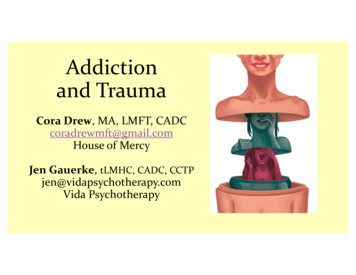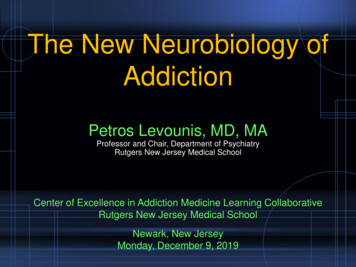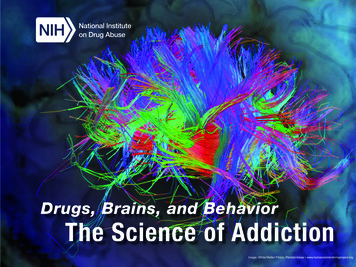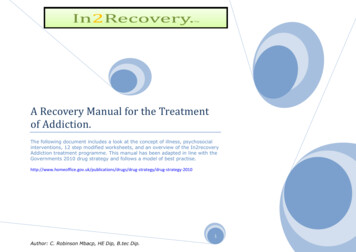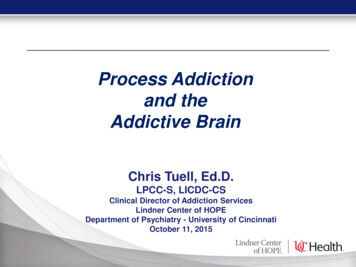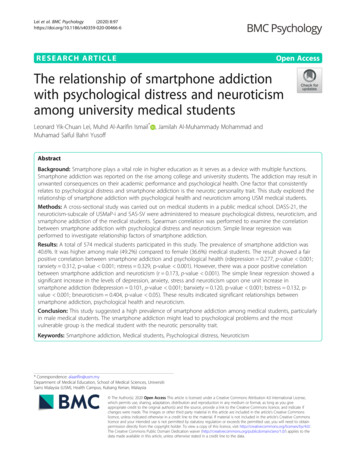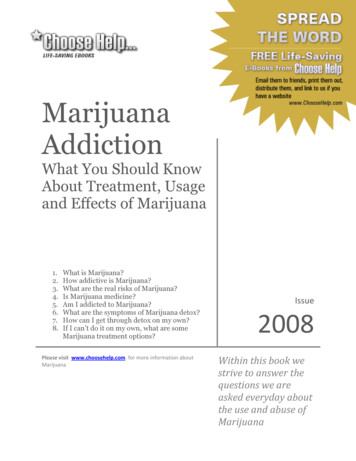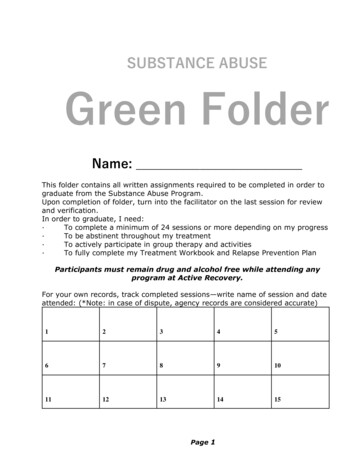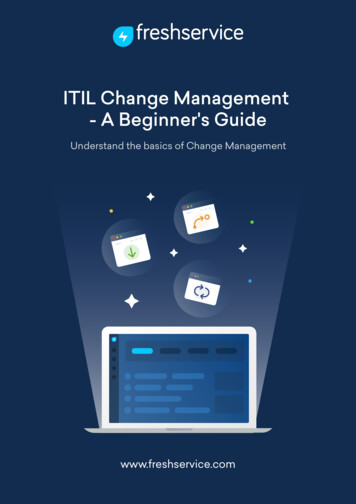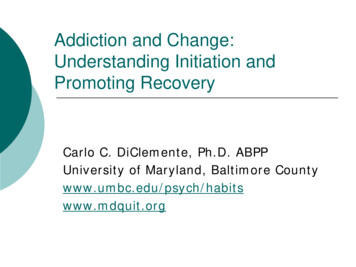
Transcription
Addiction and Change:Understanding Initiation andPromoting RecoveryCarlo C. DiClemente, Ph.D. ABPPUniversity of Maryland, Baltimore Countywww.umbc.edu/psych/habitswww.mdquit.org
What are Addictions? Habitual patterns of intentional,appetitive behaviorsBecome excessive and produceserious consequencesStability of these problematicbehavior patterns over timeInterrelated physiological andpsychological componentsAddicted individuals have difficultymodifying and stopping them
Traditional Models forUnderstanding Addictions Social/Environmental ModelsGenetic/Physiological ModelsPersonality/Intra-psychic ModelsCoping/Social Learning xcessive BehaviorModelsIntegrative Bio-Psycho-SocialModels
Etiology of AddictionsConditioningGeneticsSocial InfluencesAbusePhysiologyPersonalityInitial ependenceReinforcementAll of these factors can have arrows to initial experience and then to any orall of the three patterns of use. Most could have arrows that demonstratelinear or reciprocal causality as well
Change the Integrating PrincipleNo single developmental model orsingular historical path can explainacquisition of and recovery fromaddictions A focus on the Process of Changeand how individuals change offers adevelopmental, task oriented,learning based view that can beuseful to clinicians and researchersusing a variety of traditionaletiological and cessation models
BECOMING ADDICTED Happensover a Period ofTime Has a Variable Course Involves a Variety ofPredictors that can be bothRisk and Protective Factors Involves a Process ofChange
SUCCESSFUL RECOVERYFROM ADDICTIONS Occursover long periods of time Often involves multiple attemptsand treatments Consists of self change and/ortreatment Involves changes in other areasof psychosocial functioning
Addiction and ChangeBoth acquisition of and recoveryfrom an addiction require apersonal journey through anintentional change process Journey influenced at variouspoints by many of the factorsidentified in the previouslyreviewed etiological models
A LIFE COURSE PERSPECTIVE ONADDICTION Cross sectional views and brief follow upstudies offer confusing data aboutpredictors and outcomes of preventionand cessation of addictionMultiple biological, social, individual,environmental factors influencetransitions into and out of protective andproblematic health behaviorsUnderstanding initiation and cessation ofthese behaviors requires a life courseand a process of change perspective
Motivation Motivation can be considered thetipping point for making changehappenNot a simple or single construct orbest thought of as an “on-off”switchMost of the time it is defined posthoc: if you are successful, you weremotivated
Motivation There are various models to explain motivation “Push” Models of internal dynamic forces ordrives “Pull” Models of reinforcement, goals, values “Persuasion” Models of influence, socialforces “Process” Models of readiness and tasksThe Process Model changes the conversationfrom the “what” of motivation to the “how” ofmotivation
Motivation and the Change Process Clients are not unmotivated! They either are just motivated to engage in behaviors thatothers consider harmful and problematic or are not ready to begin behaviors that we thinkwould be helpful.People who seem to have everything to gainfrom changing a behavior or doing some activityto relieve negative feelings or consequences donot do these thingsExcellent and effective self-managementtechniques are not used even after they aretaught to people who come voluntarily for helpDiClemente. Addiction and Change: How Addictions Develop and Addicted People Recover. NY: Guilford Press; 2003.CSAT Treatment Improvement Protocol Number 35. Enhancing Motivation for Change in Substance Abuse Treatment.1999;DHHS no. (SMA) 99-3354.
Motivation is Personal Motivation belongs to clients and theirprocess of change.However, motivation can be enhancedor hindered by interactions with others(including providers) and events in thelife context of the clients.Motivation is best viewed as the client’sreadiness to engage in and completethe various tasks outlined in the Stagesof Change for a specific behaviorchange.
Motivation Is Critical forSuccessful Change Both brief interventions and alcoholismand substance abuse treatment researchindicate a key role for patient motivationIn many drinking reduction studiesmotivation predicts decreases (Deltastudy of Shock Trauma patients)Project MATCH client initial motivationmeasured by multidimensional stagemeasures predicted drinking out to 3years post-treatment for outpatientsCSAT Treatment Improvement Protocol Number 35. Enhancing Motivation for Changein Substance Abuse Treatment. 1999;DHHS no. (SMA) 99-3354.Project MATCH Research Group. Alcohol Clin Exp Res. 1998;22:1300.
WHY ARE PEOPLE NOTMOTIVATED TO CHANGE? NOT CONVINCED OF THE PROBLEMOR THE NEED FOR CHANGE –UNMOTIVATEDNOT COMMITTED TO MAKING ACHANGE – UNWILLINGACTUAL OR PERCEIVED ABILITY TOMAKE A CHANGE – UNABLEDIFFERENT PARTS OF A PROCESS
HOW PEOPLE CHANGE
The Transtheoretical Model of Intentional Behavior ChangeSTAGES OF CHANGEPRECONTEMPLATION CONTEMPLATION PREPARATION ACTION MAINTENANCEPROCESSES OF s RaisingSelf-RevaluationEnvironmental ReevaluationEmotional Arousal/Dramatic ReliefSocial lus ControlReinforcement ManagementHelping RelationshipsCONTEXT OF CHANGE1.2.3.4.5.Current Life SituationBeliefs and AttitudesInterpersonal RelationshipsSocial SystemsEnduring Personal CharacteristicsMARKERS OF CHANGEDecisional BalanceSelf-Efficacy/Temptation
How Do People Change? People change voluntarily only when They become interested andconcerned about the need for change They become convinced the changeis in their best interest or will benefitthem more than cost themThey organize a plan of action thatthey are committed to implementingThey take the actions necessary tomake the change and sustain thechange
Stage of Change Labels and Tasks Precontemplation Not interestedContemplation ConsideringPreparation PreparingAction Initial changeMaintenance Sustainedchange Interested, concernedand willing to considerRisk-reward analysisand decision makingCommitment andcreating a plan that iseffective/acceptableImplementing planand revising asneededConsolidating changeinto lifestyleDiClemente. Addiction and Change: How Addictions Develop and Addicted People Recover. NY: Guilford Press; 2003.DiClemente. J Addictions Nursing. 2005;16:5.
A Client/Consumer perspective A Consumer Perspective to Carenecessitates a shift in emphasis from aconcentrating only on our treatments tofocusing on our consumers and theirmotivation and mechanisms of changeMost treatment services provide good,effective action-oriented treatmentsMany of our consumers are unmotivated,overwhelmed with multiple problems,feeling hopeless, or simply not interestedor engaged by our servicesDiClemente & Velasquez. Motivational interviewing and the stages of change. In: Miller & Rollnick, eds. Motivational Interviewing, 2nd ed. NY:Guilford Publications; 2002:201.
Motivation is Multidimensional Motivation is best understood as thereadiness and ability to accomplish thetasks needed to move individualssuccessfully through the stages of changeThese tasks require self-regulation skillsthat enable the person to engage in theprocesses of change needed to accomplishthe tasks and move the markers of changeThere are facilitating and hinderingpersonal and environmental factors thataffect movement through each of thestages
Understanding Motivation and Movement throughthe Stages of ationPreparationUNABLEActionMaintenanceThis Process is as relevant for organizations and service providers as it is forIndividuals with mental health and addiction problems.
Tasks and Goals for each of the Stagesof Change PRECONTEMPLATION - The state inwhich there is little or no consideration ofchange of the current pattern of behaviorin the foreseeable future.TASKS: Increase awareness of need forchange and concern about the currentpattern of behavior; envision possibility ofchangeGOAL: Serious consideration of changefor this behavior
WHAT INDIVIDUALS or ORGANIZATIONSMUST REALIZE MY BEHAVIOR ISPROBLEMATIC OREXCESSIVEMY DRUG USE ISCAUSINGPROBLEMS IN MYLIFEI HAVE OR AM ATRISK FOR SERIOUSPROBLEMSMY BEHAVIOR ISINCONSISTENTWITH SOMEIMPORTANT VALUESMY LIFE IS OUT OFCONTROL WHAT WE ARE DOINGIS NOT EFFECTIVE INMEETING THE NEEDSOF OUR CLIENTSOUR APPROACH ISCOSTING TOO MUCHFOR THE OUTCOMESWE ARE GETTINGTHERE ARE SERIOUSPROBLEMS IN OURPROCEDURES,PROGAMMMING,ORPRODUCT
Key Issues and InterventionConsiderations Coercion or Courts cannot do it aloneConfrontation breeds ResistanceMotivation not simply Education isneededIntrinsic and Extrinsic MotivationsProactive versus ReactiveApproachesSmaller versus Larger goals andMotivation
Tasks and goals for each of the Stagesof Change CONTEMPLATION – The stage wherethe individual or society examines thecurrent pattern of behavior and thepotential for change in a risk – rewardanalysis.TASKS: Analysis of the pros andcons of the current behavior patternand of the costs and benefits of change.Decision-making.GOAL: A considered evaluation thatleads to a decision to change.
Decisional Balance WorksheetNO CHANGECHANGEPROS (Status Quo)CONS (Status Quo)CONS (Change)PROS (Change)
Key Issues and InterventionConsiderations Decisional Considerations are PersonalIncrease the Costs of the Status Quo andthe Benefits of ChangeChallenge and Work with AmbivalenceEnvision the ChangeEngender Culturally RelevantConsiderations that are MotivationalSee how families and larger organizationscan influence change by providingincentives or putting up barriersMultiple problems or issues interfere andcomplicate
MOTIVATED TO CHANGE Admit that the status quo isproblematic and needs changingThe pros for change outweigh theconsChange is in our own best interestThe future will be better if we makechanges in these behaviorsBut this is only the first two stepstoward making a change happen
Tasks and goals for each of theStages of Change PREPARATION – The stage inwhich the individual ororganization makes a commitmentto take action to change thebehavior pattern and develops aplan and strategy for change.TASKS: Increasingcommitment and creating achange plan.GOAL: An action plan to beimplemented in the near term.
Key Issues and InterventionConsiderations Effective, Acceptable and AccessiblePlansSetting Timelines forImplementationBuilding Commitment andConfidenceCreating IncentivesDeveloping and Refining SkillsNeeded to Implement the PlansTreatment Plan and Change Plan
WILLING TO MAKE CHANGE COMMITMENT TO TAKE ACTIONSPECIFIC ACCEPTABLE ACTIONPLANTIMELINE FOR IMPLEMENTINGPLANANTICIPATION OF BARRIERSBUT YOU STILL HAVEN’T DONE ITYET
Tasks and goals for each of theStages of Change ACTION – The stage in which theindividual or organization implements theplan and takes steps to change the currentbehavior pattern and to begin creating anew behavior pattern.TASKS: Implementing strategies forchange; revising plan as needed;sustaining commitment in face ofdifficultiesGOAL: Successful action to changecurrent pattern. New pattern establishedfor a significant period of time (3 to 6months).
Key Issues and InterventionConsiderations Flexibleand ResponsiveProblem Solving Support for Change Reward Progress Create Consequences forFailure to Implement Continue Development andRefining Skills Needed toImplement the Plan
Tasks and goals for each of theStages of Change MAINTENANCE – The stage where thenew behavior pattern is sustained for anextended period of time and isconsolidated into the lifestyle of theindividual and society.TASKS: Sustaining change over timeand across a wide range of situations.Avoiding going back to the old pattern ofbehavior.GOAL: Long-term sustained changeof the old pattern and establishment of anew pattern of behavior.
Key Issues and InterventionConsiderations It is Not Over Till Its OverSupport and ReinforcementAvailability of Services orResources to Address Other IssuesIn Contextual Areas of FunctioningOffering Valued Alternative Sourcesof ReinforcementInstitutionalization of change
ABLE TO CHANGE Continued CommitmentSkills to Implement the PlanSelf Control Strength that is notexhausted by other problemsLong-term Follow ThroughIntegrating New Behaviors intoLifestyle or OrganizationCreating a New Behavioral NormNow you are getting there
Relapse and Recycling - Slipping Back toPrevious Behavior and Trying to ResumeChangeCharacteristics: The person or organizations has failed toimplement the plan or is re-engaged inthe previous behavior After failing to implement or reverting toprevious behavior, there is re-entry toprecontemplation, contemplation,preparation stages Sense of failure and discouragementabout motivation or ability to change
Regression, Relapse and Recycling throughthe Stages Regression represents movement backwardthrough the stagesSlips are brief returns to the prior behaviorthat represent a some problems in the actionplanRelapse is a return or re-engaging to asignificant degree in the previous behavior aftersome initial changeAfter returning to the prior behavior, individualsRecycle back into pre-action stages(precontemplation, contemplation, orpreparation).
Key Issues and InterventionConsiderations Blame and Guilt UndermineMotivation for ChangeDetermination despite delays anddefeatsSupport Re-engagement in theProcesses of ChangeRecycling or just Spinning WheelsHope and a Learning Perspective isNeeded
Theoretical and practical considerations related tomovement through the Stages of ChangeMotivationPrecontemplationPersonal EnvironmentalOrganizationalConcerns ce(Pros & nanceRelapse
Stages of Change ModelPrecontemplationIncrease awareness of need to changeContemplationMotivate and increase confidencein ability to changeRelapsePreparationAssist in CopingNegotiate a planMaintenanceEncourage activeproblem-solvingTerminationActionReaffirm commitmentand follow-up
THE STAGES OF CHANGE FOR ADDICTION AND RECOVERYADDICTIONDependencePCCPAAMPROCESSES, CONTEXT AND MARKERSOF CHANGEPCDependenceCPARECOVERYAMSustainedCessation
Theoretical and practical considerations related to Preventionand Stages of sion-MakingContemplationPersonal Environmental DecisionalConcerns PressureBalance(Pros & ialProcessesCasual esRegular UseDependence
PREVENTION OF INITIATION OF ADDICTIONPC - CC - PAPOPULATIONPREVENTIONPA - AAT- RISKPREVENTIONA-MALREADYAFFLICTED
A STAGE BY ADDICTIVE BEHAVIOR PERSPECTIVE ON ALLENTYPE OFBEHAVIORSTAGE OF SDGAMBLINGEATING DISORDERMXALCOHOLNICOTINEHEROINAXX
Stage Based EpidemiologyPCPCCMPA AMCAPA
Implications for Acquisition andPrevention If there is a common but uniquepathway, we can better understandwhere individuals are in this processof change for each addictivebehaviorWe can distinguish betweenprevention and treatment betterWe can target interventions to theprocess of change
Stages of Change and Therapist’s TasksPrecontemplationContemplationPreparationRaise doubt—Increase the client’s perception ofrisks and problems with current behaviorTip the decisional balance—Evoke reasons forchange, risks of not changing; strengthen client’s selfefficacy for behavior changeHelp the client determine the best course ofaction to take in seeking change; develop a planActionHelp the client implement the plan; use skills;problem solve; support self-efficacyMaintenanceHelp the client identify and use strategies to preventrelapse; resolve associated problemsRelapseHelp the client recycle through stages ofcontemplation, preparation, and action, withoutbecoming stuck or demoralized because of relapseCSAT Treatment Improvement Protocol Number 35. Enhancing Motivation for Change inSubstance Abuse Treatment. 1999: DHHS no. (SMA) 99-3354.
How Do Interventions Work?INDIVIDUALINTERVENTIONStatic Interaction Model
How Do Interventions Work?Dynamic Model: Stepping into a Flowing Stream
How Do Interventions Work?Individual’s Status on Developmental and ChangeProcess Factors During Course of Drinking18 yo college studentweekend bingedrinking23 yo graduateexperimenting withrecreational drugswhile binge drinkingIntervention34 yo, new fatheroccasional heavydrinking following7 years of sobrietyIntervention46 yo executive,recently divorced,Depressed,4-5 drinks a night
Project MATCH Tested 3 distinct alcohol treatments– Cognitive Behavioral Treatment (CBT) (12/12 wks)– Twelve Step Facilitation (TSF) (12/12 wks)– Motivational Enhancement Therapy (MET) (4/12 wks) Examined 21 hypothesized matching effects and over 30baseline predictors of drinking Comprised 9 centers with over 20 sites and 75 therapists Included 952 outpatients and 774 aftercare patientsProject MATCH Research Group. J Stud Alcohol. 1997;58:7.
10.80.624 MONTH12 MONTH9 MONTH6 MONTH3 MONTH0POST TX0.2Timeline relative to treatment windowProject MATCH Research Group. Alcohol Clin Exp Res. 1998;22:1300.36 MONTHCBTMETTSF0.4BASELINEPercentage days abstinentPercentage Days Abstinent: Baselineto 36Month Follow-up Across MATCH Therapies(Outpatient Sites)
Success Profiles From Project MATCH TSF, CBT, and MET treatments produced similar drinkingoutcomes However, the dimensions of the process of change wereimportant in discriminating between the various outcomesin Project MATCH What happens to them during treatment? How do they relate to long-term drinking outcomes?Carbonari & DiClemente. J Consult Clin Psychol. 2000;68:810.
End-of-Treatment-Process ProfilesPredict Outcomes Client status during follow-up period:– Abstinent– Moderate drinking– Heavier drinking Client profile on Stage of Change subscales,temptation to drink, abstinence, self-efficacy,experiential and behavioral processes of changeCarbonari & DiClemente. J Consult Clin Psychol. 2000;68:810.
Standard scoresTTM Profile:Outpatient PDA onModerateActMainHeavierConfTTM variablesTTM Transtheoretical modelCarbonari & DiClemente. J Consult Clin Psychol. 2000;68:810.Temp
Standard ScoresTTM Profile:Outpatient PDA ntPreConActModerateMainConfHeavierTempExpTTM VariablesPDA percent days abstinentCarbonari, JP & DiClemente, CC. J Consult and Clin Psych. 2000; 68:810.Beh
TTM Profile:Aftercare PDA BaselineStandard 4-0.6-0.8PreConActMainTTM variablesCarbonari & DiClemente. J Consult Clin Psychol. 2000;68:810.ConfTemp
TTM Profile:Aftercare PDA Post-treatment0.8AbstinentStandard ConActMain Conf Temp ExpTTM variablesCarbonari & DiClemente. J Consult Clin Psychol. 2000;68:810.Beh
PROCESS T
Where Do We Go From Here? Stepped care approaches Matching techniques of treatment to clientproblem and process of change dimensions Integrating formal and self-help approaches aswell as different treatment approaches Client-titrated treatment Treatment shifts from being reactive andregimented to becoming proactive andpersonalizedDiClemente. Addiction and Ch
ADDICTION Cross sectional views and brief follow up studies offer confusing data about predictors and outcomes of prevention and cessation of addiction Multiple biological, social, individual, environmental factors influence transitions into and out of protective and problematic health behaviors Understanding initiation and cessation of
